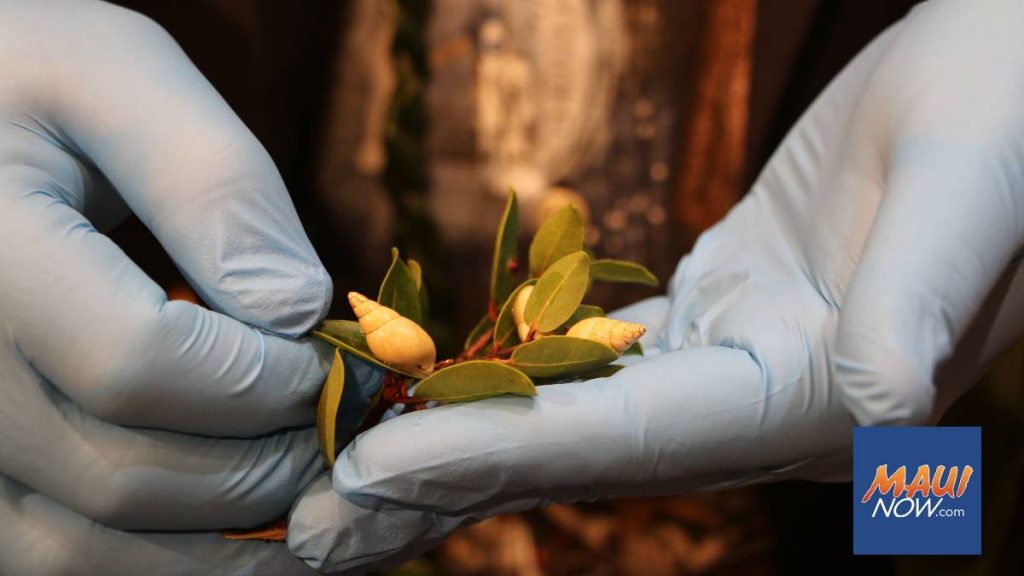Year of the Kāhuli proclaimed for Hawaiʻi: Tiny native Hawaiian snails have big purpose


To recognize the big importance of tiny snails from Hawai’i, Gov. John Green on Thursday proclaimed 2023 the Year of the Kāhuli.
The governor signed a proclamation Thursday that hails the native Hawaiian species, which inhabited almost every ecosystem across the state and played a key role in the natural and cultural life of Hawai’i, according to a state Department of Land and Natural Resources news release.
In the past, there were 750 different species of kāhuli. Now, 60% have gone extinct and some entire families have disappeared from the islands.
One hundred or more species will likely go extinct in the next decade without increased research and conservation action.
Kāhuli were considered jewels of the forest and revered in Hawaiian cultural history. Like many native species, they are threatened by climate change, predators including rats and cats, introduced invasive snails, chameleons and human encroachment.
Unlike garden snails like the Rose Wolf snail, Hawaiʻi’s native snails are critical to the overall health of native ecosystems and serve as “canaries in the coal mine,” a reference to the early warnings they provide, according to Dr. David Sischo of DLNR’s Division of Forestry and Wildlife.
“As go the snails, so do many other species. When snail populations decline you can be sure other species of plants and animals are not far behind,” Sischo said.
At a snail lab operated by Sischo, 40 species of rare, native snails from five different islands are all fed and kept safe, until such time they can be returned to their forest homes. The state snail lab is in addition to those at the Honolulu Zoo and Bishop Museum.
Sischo said the lab is an “emergency room for snails that are on the brink of extinction.”
“We take really good care of them, increase their numbers, and then put them back out on the landscape in protected areas,” he said.
Typically, a population needs to be in the hundreds before researchers consider moving them out, getting them past what Sischo calls the danger zone of extinction. Last year, more than 7,000 snails from the three labs were released into the wild.
For such tiny creatures, certain species have an average life span of 20 years, but they take five years to reach maturity, and then only produce one to five offspring each year.

Not only do the snails have important ecological impacts, they are featured in stories, hula and chants and represent voice in Hawaiian culture, according to DLNR First Deputy Laura Kaakua.
“In Hawaiian traditions, snails sing,” Kaakua said.
An account of Reverend Barnacle from 1874 describes hundreds of kāhuli on a single tree, and their movement over leaves in every tree of the forest created the grandest but wildest music, as if from hundreds of Aeolian harps, wafted to me on the breezes.
“We don’t hear the kāhuli anymore, but perhaps we could with a widespread effort to protect and steward our native forests,” Kaakua added.
Sischo and his team brought several species of the colorful native snails to Thursday’s proclamation signing, while the Bishop Museum team brought less known native snails that are equally important and threatened.

Dr. Norine Yeung, Bishop Museum malacology curator, said the museum is thankful to partner with the governor and local agencies to increase awareness of the endangered kāhuli.
“We are incredibly appreciative to partner with Gov. Green and our local agencies to increase awareness of our endangered kāhuli, which includes all native Hawaiian land snails from the ground to the trees and the plain to the colorful,” Yeung said.
For more than a decade, the museum has been studying and conserving native Hawaiian land snails while working with partners such as the DLNR Snail Extinction Prevention Program to develop respective conservation initiatives, including captive rearing programs, while fostering appreciation for this highly threatened fauna through educational outreach.
The Year of the Kāhuli will be celebrated with a series of events, including the debut of the film “Kāhuli” in April, a special brew from Honolulu Beerworks called Kāhuli Brewli in April, the second annual Kāhuli Festival at Bishop Museum in September, outreach activities and art contests, the announcement said.










